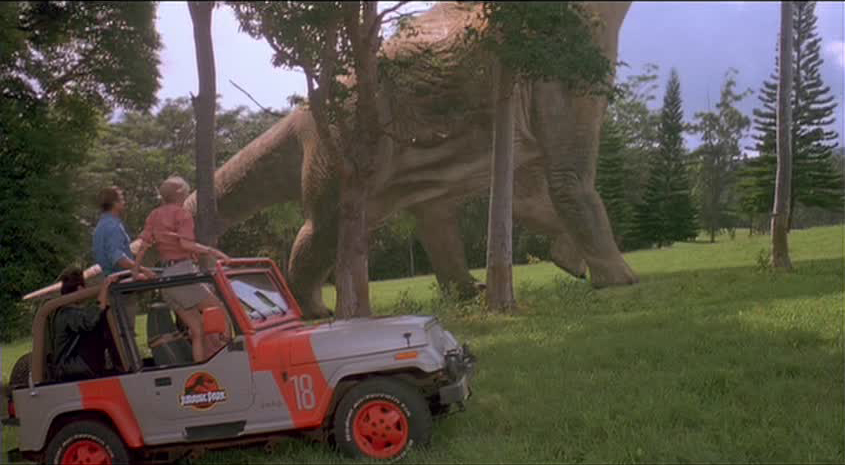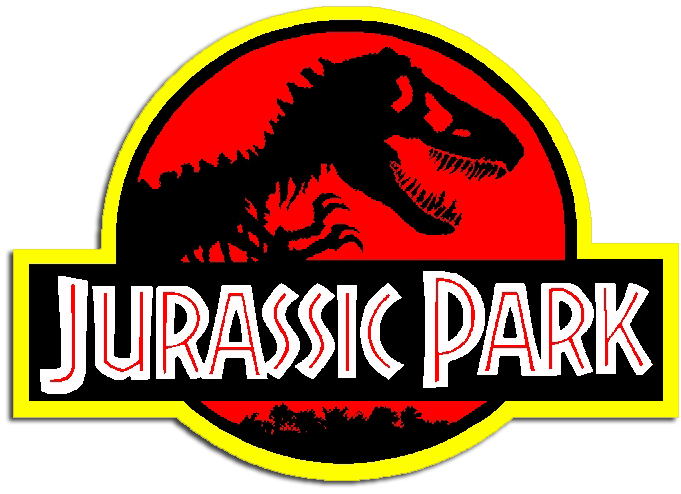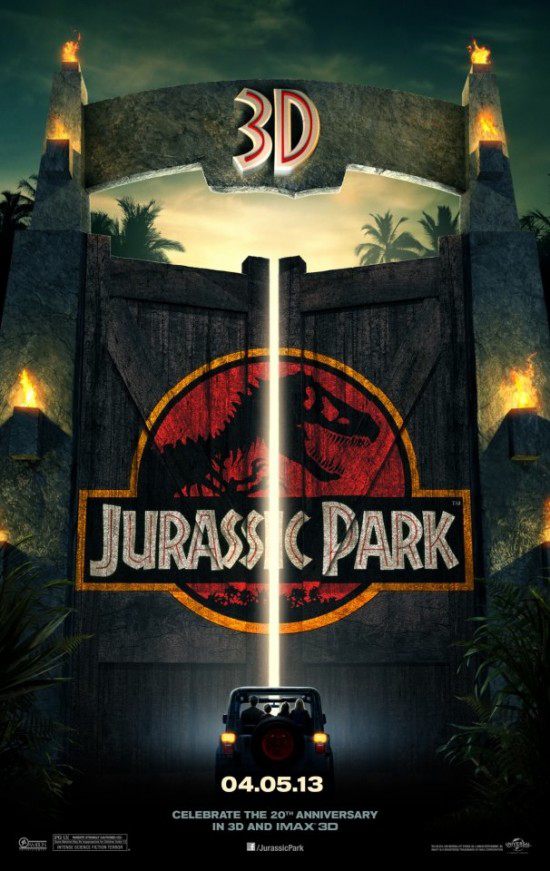Four Reasons Why Jurassic Park's Visuals Still Amaze
 Friday, April 5, 2013 at 10:00PM
Friday, April 5, 2013 at 10:00PM Twenty years ago – an eon in filmmaking years – Jurassic Park was the shiniest new toy on the block. Now it’s getting an anniversary release as a bona-fide classic, having existed for more than the entire lifespan of the teenagers that make up the target audience for splashy popcorn fare. Those twenty years have seen the computer-generated visual effects that were so radical in 1993 become more commonplace and utilitarian than ever seemed plausible back then; we live in an age when even romantic comedies and family dramas have CGI work in them. Summer tentpoles of the Jurassic Park lineage exist only in computers to such a degree that it’s really little more than convention that makes us refer to them as “live-action”.
You’d think, with all that time gone by to refine the technology, that Jurassic Park would look hideously outdated, or at best charmingly quaint. After all, the effects showpiece DragonHeart, released just a couple of years later, more resembles a cartoon now, than anything aiming for photorealism. It took less than a decade for Spider-Man to look a bit flimsy and thin; the later Harry Potter movies already seemed a bit wan when they were still in theaters. But Jurassic Park is as impressive now as it was all the way back then.
With just this one exception:

That, as far as my eyes can tell on a reasonably large TV with DVD-quality resolution, is the only bad CGI in the whole of Jurassic Park, and it’s not the fault of the model or the animation, but almost wholly the lighting (sadly, it’s also the first shot with any CGI in at all). The point is, outside of that one indifferent brachiosaur, the effects work in Jurassic Park holds up as well or better than movies made as recently as two or three years ago and the re-release won’t be nearly the worst-looking thing seen on the big screen in 2013. I’d like to share a few thoughts as to why.
There’s not that much CGI. By the time of this movie’s own unmentionable sequels, CGI had become available enough that huge portions of their VFX were done on computers. If Jurassic Park had been made today, it’s a good bet that not only every frame of a dinosaur, but several of the cars and locations would all be computer models. But in making the first movie, the filmmakers relied as much as was humanly possible on animatronics. CGI was an unknown quantity and potentially ruinous if it went wrong, so it was used solely for creatures that could not conceivably be created on set. This trains us to believe in the creatures because, they are real the first time we see them; thus we’re not hunting for the fake effects, and don’t necessarily spot them. It also means that more attention could be lavished on each individual CGI frame.
The VFX artists knew how to cheat. The T-Rex chasing the jeep in the rain. The T-Rex fighting the raptors in the dusky park headquarters. The brachiosaurs in the distance at sunset. All of them terrifically persuasive effects, and all of them take place in low light. It’s much easier to hide the flaws in technology when you’re keeping the audience from getting a good look, or distracting us with exploding tree branches. The one major effects sequence that takes place in full daylight, the gallimimus stampede, does the same thing using high speed and motion blur. With CGI everything, modern movies have to suck it up and present their work in plain view, ready to be picked apart.

It was really, really important that the CGI be perfect. In 2013, we’re so used to CGI that even when it’s bad, it really just fades into the background. It’s like dodgy rear projection in ‘30s movies: that’s the tool they use to create a certain reality, and if that reality isn’t perfect, oh well, it’s better than nothing. The occasionally weak effects work that crops in The Avengers or The Hobbit: An Unexpected Journey aren’t going to cost their sequels a penny. We’re too inured to the limitations of CGI-on-a-tight-schedule to notice a pasted-on Orc or a crummy flying aircraft carrier any more than you’d seriously criticize a movie for the font in the opening credits. But in 1993, there was no such contract of lazy acceptance between artist and audience. Filmgoers were promised amazing dinosaurs, and if they didn’t get them, the whole edifice of Jurassic Park collapsed. So the filmmakers were obliged to invest as much time, energy, and money as it took to get it exactly right, knowing that they’d be under an extraordinary amount of scrutiny.
Most importantly, the effects serve the movie, not the other way around. Think, if you will, of Avatar. Gorgeous movie. Revolutionary movie. A movie that is going to be completely unwatchable at some point, because the solitary point of it was to present the most immersive CGI world ever created. Not to tell a compelling story, not to introduce us to exciting characters. All it takes is one slightly more immersive world, and Avatar is nothing but a historical footnote.
![]() Will "Pandora" in Avatar still feel like an immersive world in 2029?
Will "Pandora" in Avatar still feel like an immersive world in 2029?
Jurassic Park, though it was every bit as revolutionary as Avatar, was never a movie about using CGI to create dinosaurs. It is a movie about dinosaurs running amok and killing people, and in the interests of making that scenario as tangible as possible, they happen to be realized in CGI. That, more than anything, is what makes the VFX hold up: it’s not supposed to draw our attention in the first place, and if the film is working, we’re too busy attending to the action to stop and notice compositing issues or the like. It’s the same basic sleight-of-hand that Steven Spielberg had previously relied on get through Jaws, 18 years earlier: that rubbery shark looks worse than anything in Jurassic Park, but we’re invested in the movie by the time it shows up that it simply doesn’t matter. So it is with the T-Rex and crew.
That first brachiosaur, and the scene that follows, is the only moment where the CGI is meant to be gawked at it, and it’s by far the weakest effects work in the film. Otherwise, the movie uses CGI to facilitate its thriller narrative, not to replace it. This is, even now, the key to really great effects work: think of Gollum or Life of Pi’s Richard Parker, two of the best creations of the 21st Century. They, too, aren’t there to be stunning and impressive and grand, but to drive a story, and the films make us want to believe in them. It’s a simple, focused approach to blockbuster filmmaking that gets much too frequently ignored in dazzle-driven summer moviemaking; it’s also the reason that films like Jurassic Park are remembered two decades on, when so many blockbusters barely can hang on in the imagination for more than a season or two.

- Are you attending the rerelease?
- Are you excited for Wednesday night's Best Shot episode on this 1993 classic?




Reader Comments (13)
I'm gonna go see Jurassic Park, because I've never seen it in theaters and this is a chance to rectify that.
I pray to almighty Spielberg there's a 2d version, though. no fake, overpriced 3D ticket sales from me, Hollywood.
I love Laura Dern but her gaping mouth when she sees that first dinosaur is also a terrible special effect. hee. Still, she's fun in that movie. love the dung scene.
but you're right. a little CGI goes a long way. it should totally be enhancements. not the whole deal.
A really good assessment of the film and why it's effects were so important. Despite my feelings about Spielberg, there is no way that this movie cannot be evaluated in the progression of film that involve story and special effects together. I actually think that it's his best film and the one he will always ultimately be remembered for (although there are a few others that might make the list too).
I'll always love Jurassic Park. That movie was the first movie-going experience that stuck with me. I was six, and my dad kept saying that it would be like the dinosaurs were right behind me. The visual effects are still some of the best ever, but the sound work might top it. It was the perfect popcorn movie as a kid, and it still holds up now.
I was reading an article yesterday that explained in very broad strokes how the CGI was done. Since they couldn't do realistic enough animations from scratch, they basically programmed the existing animatronics into the computer and manipulated the digital models like the physical puppets on set. It's a only a couple steps away from how motion capture suits work. They had the existing models and they digitized them to manipulate in the film.
The low light is really key, as well. The reason theme park animatronics--especially the Disney dark ride stuff--work so well is the darkness. When you ride Dinosaur in Animal Kingdom, the giant T-Rex (?) at the end looks real because he's eclipsed in darkness and physically present in the scene. With the lights on, the illusion is not nearly as effective.
The same goes for professional haunted houses that do claustrophobia rooms--with the walls coming in at you--or even the vortex tunnels--the narrow bridges through the spinning blacklight wheels that can make you feel like the room is spinning or the door is moving further away from you. If you can't see the how of an effect, you can accept it as real in the world of the story.
I suppose, a frail, veil of indifference, would do the trick.
Hey, Robert G, do you have a citation for that article. I have students researching special effects this semester, and this could help them out.
This is one of the best articles I've read on here and the best summary of why CGI-driven movies are the most boring and formulaic films on the market today. Great read and I love how you get to discuss it by comparing Jurassic Park to the crap we get today.
I saw JP3D last Friday and it is still such a fun and fascinating adventure. The usual Spielbergian flaws aside, the character development and the anticipation of the action are so good. The film really does remind me of Jaws in that sense.
All I'll say about the 3D is that it's just as distracting and useless as it is in any other movie and I really hate that the only way a classic movie will get re-released these days is in 3D. I'm just glad they didn't decide to remake Jurassic Park just so it could be in theaters again. Instead of remaking classics like The Evil Dead and Carrie, why not just re-release the original? I hate Hollywood, but oh well.
By the way, I also saw Evil Dead this weekend and it sucked.
Agree with all of your points. Just watched it again and it is a perfect entertaining film. Maybe Spielberg's best in form and concept.
But not to cause too much hassle, apparently all the CGI was re-touched for the 3D version since the original texture of the animals didn't hold on the rotoscoping process.
It is still a great movie because it focuses on story and does rely as little as it can on VFX.
There's one reason, and one reason alone the movie looks so good. They spared no expense.
Couldn't it also be that it still looks good because these effects are based on actual animals and not some fantastical creature (e.g. dragons)?. Sure we will likely never _really_ know how they moved, but conjecturing they're movement based on extant animals -- while beating it into the audience's skulls that these are "really big birds" -- gives them verisimilitude.
One other major reason the effects hold up is because no one's ever seen a real dinosaur before. Using the same CGI to create an elephant would come off as a lot lower quality because everyone has seen real elephants and can more easily tell the difference.
when making a decision to be our purchaser, we can assure you the first-class carrier, there's to make you sense glad. each of our escorts is lovely and versatile of their methods so irrespective of your goals are, you will get them fulfilled right here.
Contact me 08123770473, 8147349718 Visit us http://msdipali.com